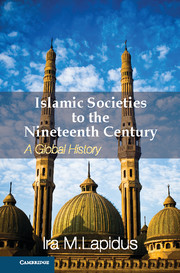Book contents
- Frontmatter
- Contents
- List of Illustrations
- List of Figures
- List of Maps
- List of Tables
- Preface
- Acknowledgments
- Acknowledgments to the first edition of A History of Islamic Societies
- Acknowledgments to the second edition of A History of Islamic Societies
- Publisher's Preface
- Introduction to Islamic Societies
- Part I The Beginnings of Islamic Civilizations
- Part II From Islamic Community to Islamic Society
- Part III The Global Expansion of Islam from the Seventh to the Nineteenth Centuries
- Chapter 25 Introduction: Islamic Institutions
- The Western Islamic Societies
- Islam in Asia
- Chapter 30 Introduction: Empires and Societies
- Chapter 31 The Turkish Migrations and the Ottoman Empire
- Chapter 32 The Postclassical Ottoman Empire: Decentralization, Commercialization, and Incorporation
- Chapter 33 The Arab Provinces Under Ottoman Rule
- Chapter 34 The Safavid Empire
- Chapter 35 The Indian Subcontinent: The Delhi Sultanates and the Mughal Empire
- Chapter 36 Islamic Empires Compared
- Chapter 37 Inner Asia From the Mongol Conquests to the Nineteenth Century
- Chapter 38 Islamic Societies in Southeast Asia
- Islam in Africa
- Conclusion
- Glossary
- Bibliography
- Annotated Bibliography from A History of Islamic Societies, 2nd Edition
- Index
Chapter 36 - Islamic Empires Compared
Published online by Cambridge University Press: 05 February 2013
- Frontmatter
- Contents
- List of Illustrations
- List of Figures
- List of Maps
- List of Tables
- Preface
- Acknowledgments
- Acknowledgments to the first edition of A History of Islamic Societies
- Acknowledgments to the second edition of A History of Islamic Societies
- Publisher's Preface
- Introduction to Islamic Societies
- Part I The Beginnings of Islamic Civilizations
- Part II From Islamic Community to Islamic Society
- Part III The Global Expansion of Islam from the Seventh to the Nineteenth Centuries
- Chapter 25 Introduction: Islamic Institutions
- The Western Islamic Societies
- Islam in Asia
- Chapter 30 Introduction: Empires and Societies
- Chapter 31 The Turkish Migrations and the Ottoman Empire
- Chapter 32 The Postclassical Ottoman Empire: Decentralization, Commercialization, and Incorporation
- Chapter 33 The Arab Provinces Under Ottoman Rule
- Chapter 34 The Safavid Empire
- Chapter 35 The Indian Subcontinent: The Delhi Sultanates and the Mughal Empire
- Chapter 36 Islamic Empires Compared
- Chapter 37 Inner Asia From the Mongol Conquests to the Nineteenth Century
- Chapter 38 Islamic Societies in Southeast Asia
- Islam in Africa
- Conclusion
- Glossary
- Bibliography
- Annotated Bibliography from A History of Islamic Societies, 2nd Edition
- Index
Summary
Each of the Islamic empires of West and South Asia – the Safavid, the Ottoman, and the Mughal – had a unique history, but the three had many features in common. They were all built on the combined heritage of past Middle Eastern imperial Islamic societies and the heritage of Inner Asian, Mongolian, and Turkic political institutions. In the Iranian tradition government was entrusted to hereditary rulers. The Turkish conception of society was based on military competition. Rulership in Turkish society was achieved by victory in battle and was maintained by active struggle against rivals. In the three empires, Iranian traditions of kingship, social hierarchy, and justice were combined with Turkish concepts of mythical heroes and glorious ancestors.
Whereas Mongol and Timurid precedents called for partitioning an empire among the sons of the ruler and allowed them to fight one another for power, the Safavids, Ottomans, and Mughals established, with some exceptions, a routinized dynastic succession. Each empire was built around a patrimonial or household government, elements of a centralized bureaucracy, a quasi-feudal assignment of tax revenues to support the military and to carry on local administration, and finally the extensive farming out of tax collection and other governmental functions to create patronage networks that bound soldiers, provincial officials, and local notables to the central government. All three empires had the support of royal armies (sometimes slave military forces and sometimes lower-class recruits), bureaucratic personnel, provincial feudal and tribal notables, landowners, merchants, and religious elites. There were important differences in the weight and balancing of the several bases of imperial power. The Ottomans probably had the most centralized regime; the Mughals were notably more patrimonial and less bureaucratic; the Safavid regime, the most patrimonial, was dependent on religious prestige and on the support of administrative and tribal notables. From the fourteenth century, the Ottomans relied on slave military forces; the Safavids introduced such forces in the sixteenth century, but the Mughals by and large depended on freeborn Muslims and Hindus.
- Type
- Chapter
- Information
- Islamic Societies to the Nineteenth CenturyA Global History, pp. 538 - 542Publisher: Cambridge University PressPrint publication year: 2012



